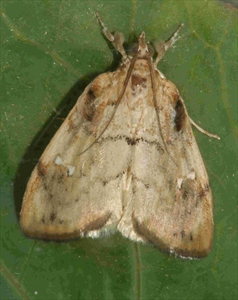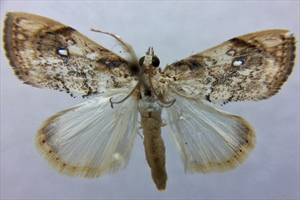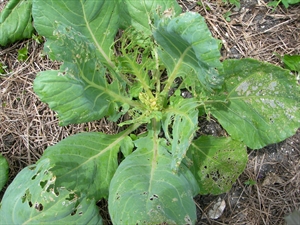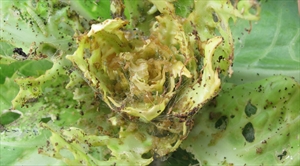Cabbage cluster caterpillar, large cabbage moth (LCM), large cabbage-heart caterpillar
Pacific Pests, Pathogens, Weeds & Pesticides - Online edition
Pacific Pests, Pathogens, Weeds & Pesticides
Cabbage cluster caterpillar (LCM) (078)
Crocidolomia pavonana; previously, known as Crocidolomia binotalis. It is a moth of the Crambidae.
Asia, Africa, Oceania. It is recorded from Australia, Cook Islands, Federated States of Micronesia, Fiji, Guam, New Caledonia, Niue, Northern Mariana Islands, Papua New Guinea, Samoa, Solomon Islands, Tonga, and Vanuatu. In many of these countries, the species is given as binotalis, an older name.
Members of the brassica family - broccoli, cabbage, cauliflower, Chinese cabbage, mustard and radish.
The larvae or caterpillars feed on all stages of the plants, although they rarely attack seedlings.
Eggs are laid on the underside of the outer leaves in a mass of 10 to more than a 100. They are pale green at first, becoming bright yellow, and then brown before hatching. The caterpillars grow to 20 mm, with long hairs and white or pale green stripes (Photo 1); the later stages make thick webs over the leaves, and the caterpillars feed beneath them. Often, they feed at the plant centre.
The caterpillars pupate in the soil. The adult moth is light brown, just less than 20 mm long, with two small white triangular spots on each forewing (Photos 2&3).
The life cycle is about 22 days in the lowlands, and 35 days in the highlands.
Damage is often severe as the caterpillars feed on the 'heart' or centre of plants (Photos 4&5). The caterpillars often occur with those of diamondback moth. Even a single caterpillar is capable of causing significant damage and, therefore, economic loss.
Look for the egg masses on the lower surfaces of the leaves, along the midrib and main veins. Look for caterpillars at the centre of cabbages with white or pale green stripes; look for the presence of webbing and faeces (small brown droppings).
NATURAL EMEMIES
There is little information about natural enemies in Pacific island countries. A braconid wasp and a tachinid fly occur in Papua New Guinea, but neither is able to prevent high levels of damage. Generalist predators, e.g., ladybird beetles and lacewing larvae are also likely to attack large cabbage-heart caterpillars. In Samoa, a strain of Trichogramma chilonis has been found that lays its eggs in the eggs of Crocidolomia pavonana.
CULTURAL CONTROL
Before planting:
- Check seedlings in the nursery for egg masses and young caterpillars; if found, remove the leaves or the entire plants and destroy them.
- Use mustard (Brassica juncea) or Chinese cabbage as trap crops, planting it as a companion between rows of cabbages and other brassica species. Mustard is a preferred host for this insect pest and protects the cabbages from destruction. Plant the first row of mustard about 15 days before transplanting the cabbages, and the second row about 25 days after transplanting.
- Plant far from old plots of brassicas to prevent infestation from previous plots.
During growth:
- Handpick caterpillars from plants in the field when numbers of insects are low.
- Grow plants under nets or in screen houses, if resources allow.
After harvest:
- Collect and destroy crop debris after harvest.
CHEMICAL CONTROL
- Use plant-derived products (with the addition of soap), such as neem (see Fact Sheet no. 402), derris, pyrethrum and chilli (see Fact Sheet no. 504), or commercial products that are derived from certain disease-causing organisms, such as spinosad (Success) and Bt - Bacillus thuringiensis subspecies kurstaki var. kurstaki, or var. aizawai.
- If using Bt (Bacillus thuringiensis), note the following:
- The spray needs to be applied carefully so that there is good coverage of the plant as the insecticide has to be eaten by the caterpillars to kill them.
- Eggs are not susceptible to Bt.
- Small larvae are more susceptible to Bt than fully grown ones.
- Use Bt as soon as damage is seen.
- Avoid using broad-spectrum insecticides (such as pyrethroids and organophosphates) as they will kill natural enemies.
____________________
When using a pesticide, always wear protective clothing and follow the instructions on the product label, such as dosage, timing of application, and pre-harvest interval. Recommendations will vary with the crop and system of cultivation. Expert advice on the most appropriate pesticides to use should always be sought from local agricultural authorities.
AUTHORS Helen Tsatsia & Grahame Jackson
Information from CABI (2014) Crocidolomia pavonana (large cabbage-heart caterpillar). Crop Protection Compendium: (https://www.cabi.org/cpc/datasheet/16126); and Herbison-Evans D (2017) Crocidolomia pavonana (Fabricius, 1794. Butterfly House. Australia.(http://lepidoptera.butterflyhouse.com.au/ever/pavonana.html); and from Mike Furlong (pers. comm.), University of Queensland, Australia. Photo 2 Department of Agriculture and Food, Government of Western Australia. (https://www.agric.wa.gov.au/cabbage/cabbage-head-caterpillar-cabbage-pest-indonesia). Photo 3 Mani Mua SPC, Sigatoka Research Station, Fiji.
Produced with support from the Australian Centre for International Agricultural Research under project PC/2010/090: Strengthening integrated crop management research in the Pacific Islands in support of sustainable intensification of high-value crop production, implemented by the University of Queensland and the Secretariat of the Pacific Community








